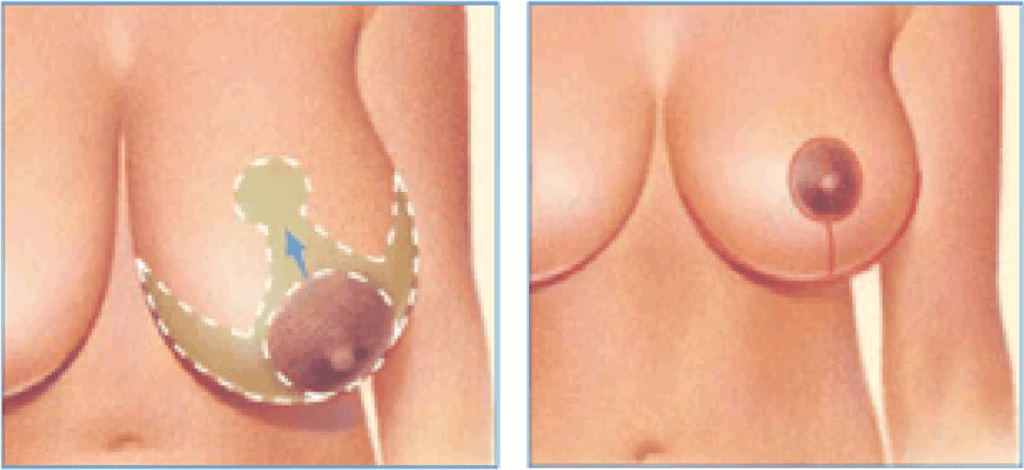Breast Reduction Surgery: Your Comprehensive Guide
Transform Your Life with Breast Reduction Surgery
Are you experiencing discomfort, pain, or self-consciousness due to overly large breasts? Breast reduction surgerymight be the solution you’ve been seeking. This procedure, also known as reduction mammoplasty, can alleviate physical discomfort and enhance your overall quality of life.

What is Breast Reduction Surgery?
Breast reduction is a good option for you if you:
- Are physically healthy
- Have realistic expectations
- Don’t smoke
- Are bothered by feeling that your breasts are too large
- Have breasts that limit your physical activity
- Experience back, neck and shoulder pain caused by the weight of your breasts
- Have shoulder indentations from bra straps
- ave skin irritation beneath the breast crease
Benefits of Breast Reduction Surgery
- Alleviates Physical Pain: Reduce back, neck, and shoulder pain caused by large breasts.
- Improves Posture: Enhance your posture and reduce the risk of long-term spinal issues.
- Boosts Confidence: Feel more comfortable and confident in your appearance.
- Increases Activity Levels: Engage in physical activities with ease and comfort.
- Enhances Clothing Fit: Enjoy a wider variety of clothing options that fit better and look great.
Who is a Candidate for Breast Reduction Surgery?
Ideal candidates for breast reduction surgery are individuals who:
- Experience chronic pain or discomfort due to large breasts.
- Have indentations from bra straps on their shoulders.
- Suffer from skin irritation beneath the breast crease.
- Feel self-conscious or unhappy with the size of their breasts.
- Have realistic expectations and are in good overall health.
Consultation & Preparation
During your consultation be prepared to discuss:
- Your surgical goals
- Medical conditions, drug allergies and medical treatments
- Current medications, vitamins, herbal supplements, alcohol, tobacco and drug use
- Previous surgeries
- Family history of breast cancer and results of any mammograms or previous biopsies
Your surgeon will also:
- Evaluate your general health status and any pre-existing health conditions or risk factors
- Examine your breasts and may take detailed measurements on their size, skin quality and location of your nipples and areolas
- Take photographs
- Discuss your options
- Recommend a course of treatment
- Discuss likely outcomes of breast reduction and any risks or potential complications
- Discuss the use of anesthesia during your breast reduction
Prior to surgery, you may be asked to:
- Get lab testing or a medical evaluation
- Take certain medications or adjust your current medications
- Provide the results of your most recent mammogram, or obtain a new mammogram if you are not up to date with recommended guidelines
- Stop smoking
- Avoid taking aspirin, anti-inflammatory drugs and herbal supplements as they can increase bleeding
The Breast Reduction Surgery Procedure
Step 1 – Anesthesia
Step 2 – The incision
Incision options include:
1. A circular pattern around the areola
2. A keyhole or racquet- shaped pattern:

3. An inverted T or anchor-shaped incision pattern:

Step 3 – Removing tissue and repositioning
Step 4 – Closing the incisions
The incisions are brought together to reshape the now smaller breast. Sutures are layered deep within the breast tissue to create and support the newly shaped breasts; sutures, skin adhesives and/or surgical tape close the skin. Incision lines are permanent, but in most cases will fade and significantly improve over time.
The incision lines that remain are visible and permanent scars, although usually well concealed beneath a swimsuit or bra.
Risk & Safety of Breast Reduction Surgery
The decision to have breast reduction surgery is extremely personal. You will have to decide if the benefits will achieve your goals and if the risks and potential complications are acceptable. Although there is a fair amount of scarring associated with breast reduction surgery, it has one of the highest rates of satisfaction among procedures performed by plastic surgeons. Most women note significant improvement in their neck, back and shoulder discomfort. They are more able to participate in athletic activities, and clothing will fit differently.
Prior to undergoing breast reduction surgery, you will be asked to sign consent forms to ensure that you fully understand the procedure and any risks and potential complications.
The risks include:
- Allergies to tape, suture materials and glues, blood products, topical preparations or injectable agents
- Anesthesia risks
- Bleeding
- Blood clots
- Breast asymmetry
- Breast contour and shape irregularities
- Changes in nipple or breast sensation, which may be temporary or permanent
- Deep vein thrombosis, cardiac and pulmonary complications
- Fluid accumulation
- Infection
- Persistent pain
- Poor wound healing
- Possibility of revisional surgery
- Potential inability to breastfeed
- Potential partial or total loss of nipple and areola
- Skin discoloration and permanent pigmentation changes
- Unfavorable scarring
- Scarring within the breast tissue may cause firmness or lumps know as fat necrosis
These risks and others will be fully discussed prior to your consent. It’s important that you address all of your questions directly with your plastic surgeon.
You should know that:
- Your ability to breastfeed following reduction mammaplasty may be limited; talk to your doctor if you are planning to nurse a baby
- The procedure can be performed at any age, but is best done when your breasts are fully developed
- Changes in the breasts during pregnancy can alter the outcomes of previous breast reduction surgery, as can significant weight fluctuations
Breast Reduction Recovery
When you go home… Following your physician’s instructions is key to the success of your surgery. It is important that the surgical incisions are not subjected to excessive force, abrasion or motion during the time of healing. Your doctor will give you specific instructions on how to care for yourself and minimize breast reduction surgery risks.
If you experience shortness of breath, chest pains or unusual heart beats after surgery, seek medical attention immediately. Should any of these complications occur, you may require hospitalization and additional treatment.
You will be given specific instructions that may include how to care for your breasts following surgery, medications to apply or take orally to aid healing and reduce the potential for infection, specific concerns to look for at the surgical site or in your general health and when to follow up with your plastic surgeon.
Be sure to ask your plastic surgeon specific questions about what you can expect during your individual recovery period.
- Where will I be taken after my surgery is complete?
- What medication will I be given or prescribed after surgery?
- Will I have dressings/bandages after surgery?
- When will the dressings/bandages be removed?
- Are stitches removed? When?
- When can I resume normal activity and exercise?
- When do I return for follow-up care?
Breast Reduction Results
The results of your breast reduction surgery are immediately visible. Over time, postsurgical swelling will resolve and incision lines will fade. Satisfaction with your new image should continue to grow as you recover from surgery. The final results of your breast reduction will appear over the next few months as breast shape and position continue to settle. Incision lines are permanent but will continue to fade over time.
The results of your breast reduction surgery will be long-lasting. However, your breasts can continue to change due to aging and gravity. You’ll be able to retain your new look longer if you:
- Maintain your weight
- Keep a healthy lifestyle
Although good results are expected from your procedure, there is no guarantee. In some situations, it may not be possible to achieve optimal results with a single surgical procedure and another surgery may be necessary.
Breast Reduction Cost
Your health insurance plan may cover breast reduction surgery. Your plastic surgeon will need to obtain authorization from your insurer for the surgery. This may require a letter and the submission of photographs. Once an authorization is obtained, you will be able to schedule your surgery. You will be responsible for any co-pays or deductible required by your insurer. If your health plan does not cover breast reduction, you may decide to pay for the surgery yourself.
A surgeon’s cost may be based on his or her experience, the type of procedure used and the geographic location of the office. Your surgeon may offer patient financing plans, so be sure to ask.
Cost may include:
- Anesthesia fees
- Hospital or surgical facility costs
- Medical tests
- Post-surgery garments
- Prescriptions for medication
- Surgeon’s fee
Cost may include:
When choosing a plastic surgeon for breast reduction surgery, remember that the surgeon’s experience and your comfort with him or her are just as important as the final cost of the surgery.
Plastic surgery involves many choices. The first and most important is selecting an ASPS member surgeon you can trust. ASPS member surgeons meet rigorous standards:
- Board certification by the American Board of Plastic Surgery® (ABPS) or in Canada by The Royal College of Physicians and Surgeons of Canada®
- Complete at least six years of surgical training following medical school with a minimum of three years of plastic surgery residency training
- Pass comprehensive oral and written exams
- Graduate from an accredited medical school
- Complete continuing medical education, including patient safety each year
- Perform surgery in accredited, state-licensed or Medicare-certified surgical facilities
Frequently Asked Questions (FAQ)
What is breast reduction surgery?
Breast reduction surgery, or reduction mammaplasty, is a procedure that removes excess breast fat, glandular tissue, and skin to achieve a breast size in proportion with the body and to alleviate discomfort associated with overly large breasts.
Who is a good candidate for breast reduction surgery?
Good candidates include individuals experiencing physical discomfort such as back, neck, or shoulder pain, skin irritation, or restricted physical activity due to large breasts. Candidates should be in good health, non-smokers, and have realistic expectations about the outcome.
Is breast reduction covered by insurance?
Many insurance companies cover breast reduction surgery if it is deemed medically necessary. We can assist with the insurance process.
How is breast reduction surgery performed?
The surgery typically involves making incisions on the breasts, removing excess tissue and skin, and repositioning the nipple and areola. The specific technique used may vary depending on the patient’s anatomy and desired outcome.
What is the recovery process like after breast reduction surgery?
Recovery involves rest and limited physical activity for a few weeks. Patients may experience swelling, bruising, and discomfort, which can be managed with prescribed medications. Most people can return to work and normal activities within 2-4 weeks, but full recovery may take several months.
Are there any risks or complications associated with breast reduction surgery?
As with any surgery, there are risks such as infection, bleeding, scarring, and adverse reactions to anesthesia. Specific to breast reduction, risks include changes in nipple or breast sensation, asymmetry, and potential difficulties with breastfeeding.
Will I have noticeable scars after breast reduction surgery?
Scarring is inevitable but can be minimized with proper care and modern surgical techniques. Scars usually fade over time and can be concealed under clothing. The extent and visibility of scars depend on the surgical technique used and individual healing.
Can breast reduction surgery affect breastfeeding?
Breastfeeding after reduction surgery can be challenging, depending on how much tissue is removed and the surgical technique used. Some women may experience difficulties, while others may still be able to breastfeed successfully.
How can I prepare for breast reduction surgery?
Preparation involves consultations with the surgeon, discussing medical history, and undergoing a physical exam. Patients may need to stop smoking, avoid certain medications, and arrange for post-surgery care and transportation.
How long do the results of breast reduction surgery last?
The results are generally long-lasting, but factors such as aging, weight fluctuations, and hormonal changes can affect breast size and shape over time. Maintaining a stable weight and a healthy lifestyle can help preserve the results.
